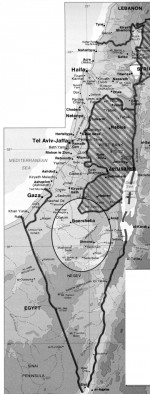The Middle East Sustainable Land Use Initiative: New Opportunity for Cross-site, Cross-agency, and Cross-culture Research
The Cooperative Monitoring Center (CMC) has invited ILTER, the Earth Data Acquisition Center (EDAC), and Israeli and Palestinian scientists to participate in a project to establish ecological observation and research monitoring stations in the Middle East.
The CMC is located at Sandia National Laboratories in Albuquerque, NM, and is funded through the Department of Energy (DOE). The CMC’s mission is to assist political and technical experts from around the world acquire the technology-based tools they need to analyze, design, and implement nonproliferation, arms control, and other security measures - including those involving environmental and natural resources.
EDAC is a service organization of the University of New Mexico, and assists industry, government, and the general public as they apply remote sensing spatial and spectral technology and training to assess natural resources, as well as other applications.
The goal of the initiative is to enhance research on sustainable land use in the Middle East and to promote collaboration between Israeli and Palestinian scientists. An essential element of the project will be collection and sharing of relevant data among the participants. The data would be collected at sites and on topics of mutual interest on the West Bank and in Israel.
A meeting in October 1998 brought together Arian Pregenzer and David Betsill from the CMC, Moshe Shachak (Mitrani Center for Desert Ecology, Beer-Sheva) and Avi Perevelotsky (Volcani Institute, Tel Aviv), Mike Inglis (EDAC), Bai-Lian (Larry) Li (UNM Dept. of Biology), Robert Waide (LTER), and others from UNM and Sandia. Discussions centered on developing cooperation among the participants and potential project topics. These topics included:
- Collecting on-site meteorological data
- Measuring in-situ soil conditions
- Linking on-site data/observations with commercial satellite imagery to develop signatures for sustainable land use
- Tracking grazing animals
- Training on remote sensing for land use research applications
- Exchanging data among the participants -- and possibly to a larger audience via the ILTER Network
The collaborative efforts of LTER, CMC, and EDAC can:
- Provide models for arid-lands research developed at the Sevilleta and Jornada sites to researchers in the Middle East
- Encourage development of common data management and sharing techniques
- Provide hardware, software, and training for exchanging scientific data
- Promote joint training and exchanges with both scientists and graduate students
- Provide training in satellite imagery analysis
- Create an environment that supports international collaborations and confidence building
Potential applications of this project include understanding the interaction of grazing animals and desert vegetation and increasing primary productivity of desert lands through "savannization."
Participants will define the exact subject and locations of the monitoring experiment. The CMC is arranging a meeting with Palestinian researchers and a visit to potential study sites on the West Bank and in the Negev in December 1998.
For more information on these organizations, see the websites:
- Mitrani Center for Desert Ecology - http://www.postfun.com/bgusf/mitrani.html
- Earth Data Acquisition Center - http://edac.unm.edu
- Cooperative Monitoring Center - http://www.cmc.sandia.gov

 Enlarge this image
Enlarge this image